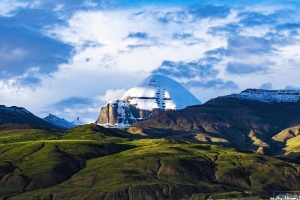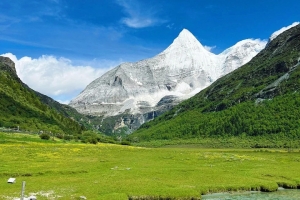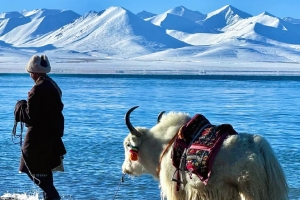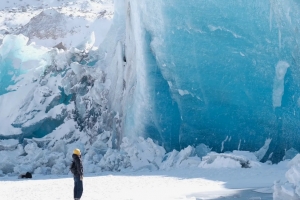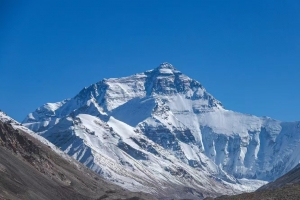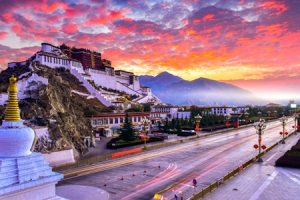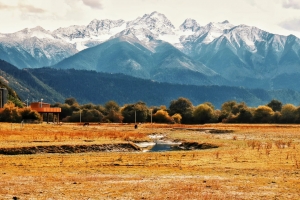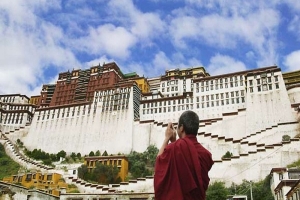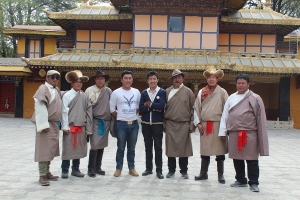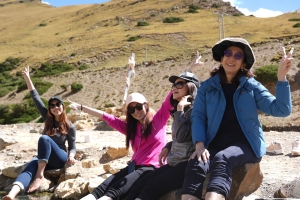Nestled in the vibrant heart of Lhasa’s Old Town, the Jokhang Temple stands as a testament to Tibetan spirituality, architectural ingenuity, and centuries of cultural evolution. With its origins dating back to the 7th century, this iconic temple not only symbolizes the deep-rooted traditions of Tibetan Buddhism but also embodies a living history of alliances, artistic exchanges, and enduring faith. This comprehensive guide delves into the multifaceted significance of Jokhang Temple—from its illustrious history and sacred relics to its unique location and profound religious importance.
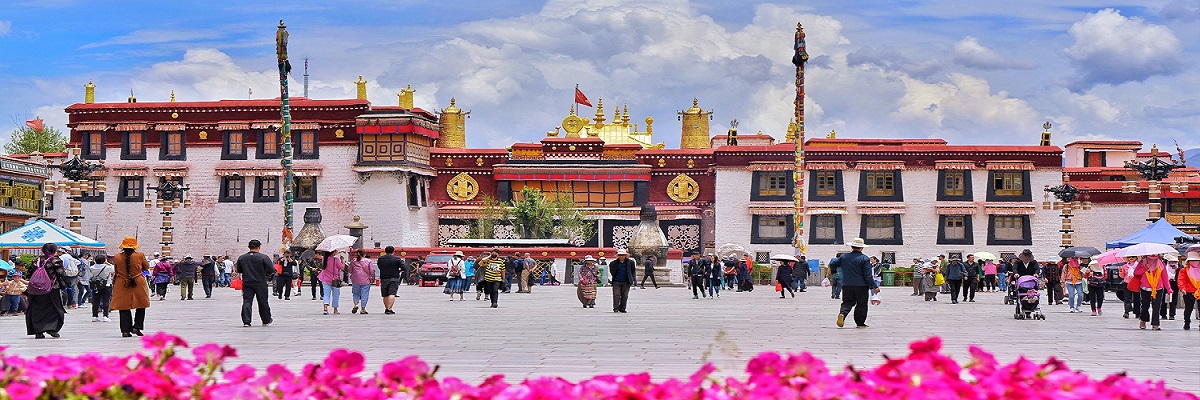
lhasa Jokhang Temple
Jokhang Temple Location: In the Heart of Lhasa
The Jokhang Temple is situated in the very center of Lhasa, within the ancient Old Town. This central location is not coincidental; it reflects centuries of planning that emphasize both spiritual and civic importance. In traditional Lhasa urban planning, no building in the central area is allowed to rise above four floors. This regulation was established to ensure that the golden roof of the Jokhang is always visible to all, symbolically watching over the city. The unobstructed view of the temple’s rooftop underscores its spiritual authority and its role as a navigational and cultural landmark in the city.
Historically, Lhasa has been regarded as the epicenter of Tibetan culture and political power. The location of the Jokhang Temple within the Old Town is significant because it serves as a living repository of Tibetan heritage. The temple is not isolated but forms a central component of a broader sacred landscape, interwoven with other religious structures, ancient markets, and residences. Its proximity to the Potala Palace, the former residence of the Dalai Lama, further accentuates its importance as part of a spiritual and political continuum in Tibet.
The unique urban policy that restricts buildings from exceeding four floors in the Old Town reinforces the temple’s dominance in the Lhasa skyline. This deliberate design choice creates a harmonious environment where the sacred and the secular blend seamlessly. Every rooftop in the city offers a glimpse of the gleaming Jokhang, a constant reminder of Lhasa’s rich spiritual legacy and the protective gaze of Tibetan Buddhism. For visitors and locals alike, the temple’s prominent position within Lhasa is both an inspiring sight and a symbol of the enduring strength of Tibetan cultural identity.
The Rich History of Jokhang Temple
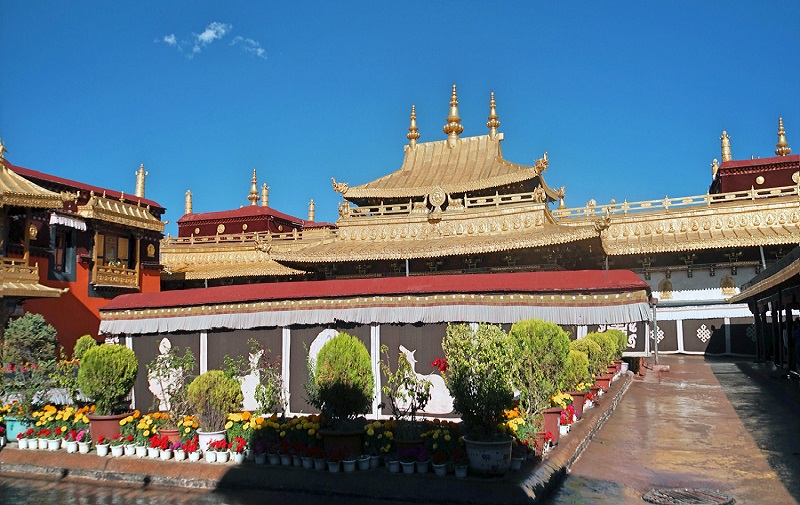
Jokhang Temple
Origins and Founding Mythos
The story of Jokhang Temple begins in the 7th century during a transformative period in Tibetan history. Founded around 647 AD by King Songtsen Gampo, the temple was constructed during a time when Tibet was forging alliances with its powerful neighbors. To solidify these alliances, King Songtsen Gampo married two princesses—Chinese Princess Wencheng and Nepalese Princess Bhrikuti. Both princesses brought with them sacred relics and statues that were deeply revered in their respective homelands.
One of these priceless relics was the statue of Jowo Shakyamuni—a representation of an eight-year-old Shakyamuni Buddha—brought to Tibet as part of the dowry from Princess Bhrikuti. The temple was deliberately oriented to face west toward Nepal, symbolically linking the cultural and spiritual influences that converged in this sacred space. Meanwhile, another important statue representing the 12-year-old Shakyamuni, gifted by Princess Wencheng, found its home in the nearby Ramoche Temple, which faces east towards China. This duality of orientation not only reflects the geopolitical realities of the time but also highlights the spiritual inclusiveness that the early Tibetan kingdom embraced.
Architectural Innovations and Symbolism
The Jokhang Temple was constructed on what was once Otang Lake—a site steeped in myth and legend. According to traditional accounts, thousands of goats played a miraculous role in the creation of the temple’s foundation by carrying soil to fill the lake. This extraordinary legend underscores the belief that the very creation of the temple was divinely orchestrated and blessed by nature itself.
Newari artisans from the Kathmandu Valley in Nepal were brought to Tibet to contribute their exceptional craftsmanship to the construction of the temple. Their intricate carvings, decorative arches, and structural ingenuity are still visible in certain elements of the Jokhang, providing tangible links to the early days of its existence. Even today, visitors can observe interior carved pillars and ancient entrance arches that date back to the 7th century, standing as enduring relics of an era when art and spirituality were inseparable.
Turbulent Times and Resilience
Over the centuries, the Jokhang Temple has witnessed numerous periods of turmoil and restoration. After King Songtsen Gampo’s death, the temple’s sacred relics became the focus of both reverence and conflict. During one tumultuous period, Tibetans were forced to hide the Jowo Shakyamuni statue within the temple to protect it from an invading Tang army intent on reclaiming it for China. The statue remained concealed for many years until it was eventually retrieved by the intervention of Queen Tride Tsugtsen’s wife, ensuring its survival through a dangerous period of conflict.
In later centuries, additional modifications were made to the temple complex. During the time of Tsongkhapa—the 14th-century founder of the Gelug sect of Tibetan Buddhism—the temple’s courtyard was added, further enhancing its spiritual ambiance and architectural harmony. The Fifth Dalai Lama later contributed to its expansion and reconstruction, reinforcing the temple’s status as a living monument that evolved with the changing tides of Tibetan history.
The Cultural Revolution and Restoration
No discussion of Jokhang Temple’s history would be complete without acknowledging the profound impact of the Cultural Revolution. During this period, the temple’s interior suffered significant damage, and numerous artifacts were stolen or destroyed. However, the resilience of the Tibetan people and the deep spiritual significance of the temple ensured that restoration efforts were swiftly undertaken. Today, the Jokhang stands not only as a monument to ancient religious practices but also as a symbol of cultural revival and preservation.
The Sacred Jowo Shakyamuni Statue in Jokhang Temple
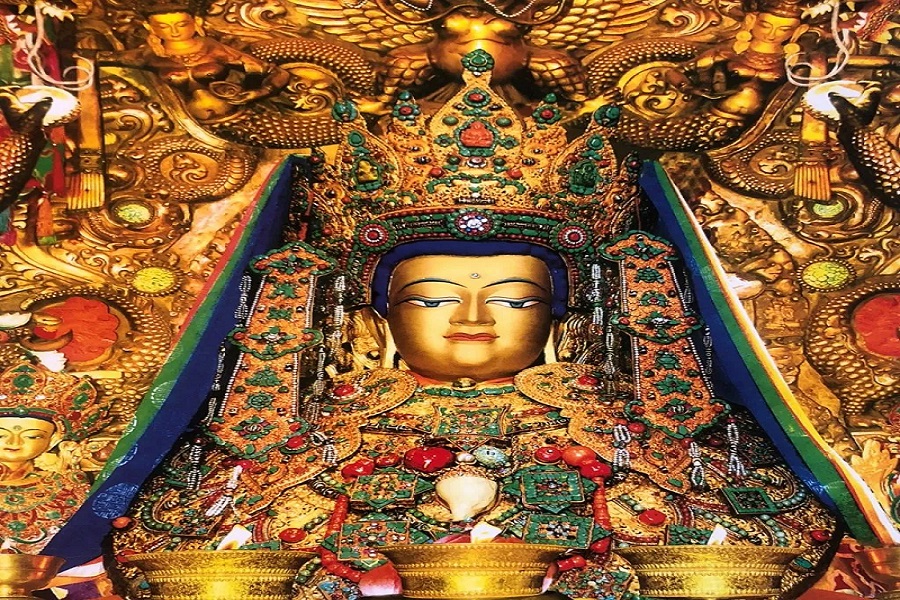
Jowo Shakyamuni
At the heart of the Jokhang Temple lies its most revered object—the Jowo Shakyamuni statue. In Tibetan, “Jowo” means supremacy, a title that underscores the statue’s divine and unparalleled significance in Tibetan Buddhism. This sacred image represents an 8-year-old Shakyamuni Buddha, the historical Buddha who founded Buddhism, and is believed to be over 2,500 years old. According to legend, the statue was consecrated by the Buddha himself, imbuing it with a sanctity that has made it a focal point for worship for centuries.
Origins and Journeys
The history of the Jowo Shakyamuni statue is as dramatic as it is ancient. Originally, the statue is said to have resided in Bodhi Gaya, India—a site intimately associated with the enlightenment of the Buddha. However, a series of events led to the statue being sent to Tibet as a precious dowry. It was ultimately brought to the Jokhang Temple by Princess Wencheng, thereby integrating it into the spiritual life of Tibet. This journey from India to Tibet encapsulates the interconnectedness of Buddhist traditions across Asia and underscores the reverence that the statue commands.
Artistic and Religious Details
The statue is not merely an artistic marvel but a sacred object laden with symbolic meaning. During the reign of Tsongkhapa, the founder of the Gelug school of Tibetan Buddhism, the statue was adorned with a golden crown featuring the symbols of the five Dhyani Buddhas. This crowning ritual was more than a decorative enhancement—it signified the statue’s supreme status and its embodiment of divine wisdom and compassion.
The depiction of the Buddha in this statue is unique. Unlike conventional images that portray Buddha as an ascetic in the later stages of enlightenment, the Jokhang statue represents him as a princely figure at the tender age of eight. This portrayal, richly decorated with gold and precious stones, speaks to the early sanctity of the Buddha and serves as a visual reminder of his miraculous birth and divine origin. For devotees, the statue is a living connection to the historical Buddha, bridging the gap between the ancient past and the present day.
Symbolism and Devotional Practices
For Tibetan Buddhists, the Jowo Shakyamuni statue is not just an object of veneration—it is a living embodiment of spiritual power. The statue plays a central role in numerous rituals, prayers, and pilgrimages. Devotees believe that meditating in its presence and circumambulating the temple can confer blessings, protection, and spiritual merit. Over the centuries, countless pilgrims have made the arduous journey to Lhasa, driven by the hope of experiencing the transformative power of this sacred relic.
Architectural Splendor and Symbolism of Jokhang
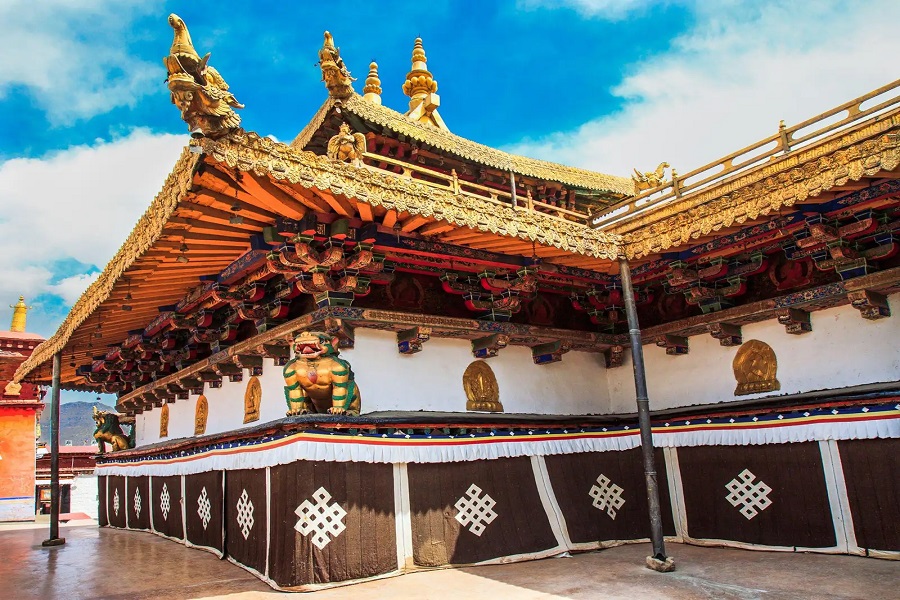
Four-Story of Jokhang
The Four-Story Marvel
One of the most distinctive features of the Jokhang Temple is its four-story structure. In traditional Lhasa, the rule that no building may exceed four floors is not merely an aesthetic choice but a deliberate effort to ensure that the Jokhang’s golden roof remains visible to all. This design decision creates a sense of unity in the urban landscape, where every structure contributes to the overall spiritual ambiance of the city. The temple’s architecture, with its detailed carvings, vibrant murals, and symbolic statues, serves as a living canvas that narrates the history and beliefs of Tibetan Buddhism.
Newari Artisan Influence
The involvement of Newari artisans from Nepal in the temple’s construction is a testament to the rich intercultural dialogue that has shaped Tibetan history. Their expertise is evident in the intricate carvings and robust architectural details that have withstood the test of time. Many of the interior pillars, entrance arches, and decorative motifs still reflect the artistry of the 7th century. These elements not only add to the temple’s visual splendor but also offer scholars and historians a tangible link to the artistic traditions of ancient Nepal and early Tibet.
Murals, Chapels, and Spiritual Spaces
Upon entering the Jokhang Temple, visitors are immediately immersed in a world of spiritual art and devotion. The temple’s courtyard is adorned with murals that chronicle the history of Buddhism, depicting scenes of divine intervention, legendary battles, and transformative rituals. As one walks through the temple, a series of chapels dedicated to various deities and revered figures are encountered. These include chapels honoring Tsongkhapa, the eight Medicine Buddhas, and Avalokiteshvara, the bodhisattva of compassion. Each chapel offers its own narrative and set of devotional practices, reinforcing the multi-layered spiritual significance of the temple.
Integration of Urban and Spiritual Elements
The integration of the Jokhang Temple within the urban fabric of Lhasa is a masterclass in sacred urban planning. The temple’s placement ensures that it serves not only as a religious center but also as a community hub. Pilgrims and locals alike gather around the temple for daily rituals, festivals, and communal prayers. The layout of the temple, with its interconnected chapels, courtyards, and stairways, invites continuous engagement with the sacred. Even the rooftop, which offers breathtaking panoramic views of Lhasa and the iconic Potala Palace, acts as a reminder of the temple’s role as a spiritual lighthouse guiding the city.
The Importance of Jokhang Temple in Tibetan Buddhism
A Pillar of the Gelug Tradition
Jokhang Temple is intrinsically linked to the Gelug school of Tibetan Buddhism, a tradition founded by the revered Tsongkhapa in the 14th century. The Gelug sect is known for its emphasis on monastic discipline, scholarly study, and ritual practice. The temple’s historical connection to Tsongkhapa is highlighted by the ritual crowning of the Jowo Shakyamuni statue with a golden crown that bears the symbols of the five Dhyani Buddhas. This act was emblematic of the temple’s role in propagating the Gelug tradition and reaffirming the supremacy of its teachings. Over the centuries, the temple has served as a beacon of spiritual guidance, drawing both scholars and devout practitioners to its hallowed halls.
A Living Monument to Tibetan Identity
Beyond its religious function, Jokhang Temple is a profound symbol of Tibetan identity and resilience. For Tibetans, the temple represents the continuity of their cultural and spiritual heritage through periods of conquest, internal strife, and external threats. The temple’s survival through the tumultuous events of history—including wars, political upheavals, and the Cultural Revolution—has cemented its status as a repository of national pride. Every carved pillar, every mural, and every relic within its walls tells a story of a people who have maintained their identity against all odds.
UNESCO Recognition and Global Impact
In recognition of its cultural, historical, and religious significance, Jokhang Temple has been designated a UNESCO World Cultural Heritage site. This prestigious status not only underscores its universal value but also ensures that the temple receives international support for its preservation. UNESCO’s recognition has brought global attention to the temple, encouraging scholarly research, tourism, and cross-cultural dialogue. For the international community, the Jokhang Temple stands as a symbol of the enduring human spirit—a monument that bridges the ancient traditions of Eastern spirituality with the modern world’s quest for meaning and connection.
Rituals, Festivals, and Devotional Practices
The Jokhang Temple is not static; it is a living, breathing center of devotional activity. Daily rituals, such as the early morning prayers and the rhythmic chants of Tibetan monks, animate the temple grounds. Special festivals—marked by vibrant processions, masked dances, and elaborate ceremonies—bring the entire community together in celebration of Tibetan Buddhist traditions. These events not only reinforce the temple’s religious importance but also strengthen community bonds and pass down ancient practices to younger generations.
Experiencing the Jokhang Temple: A Guide for Visitors
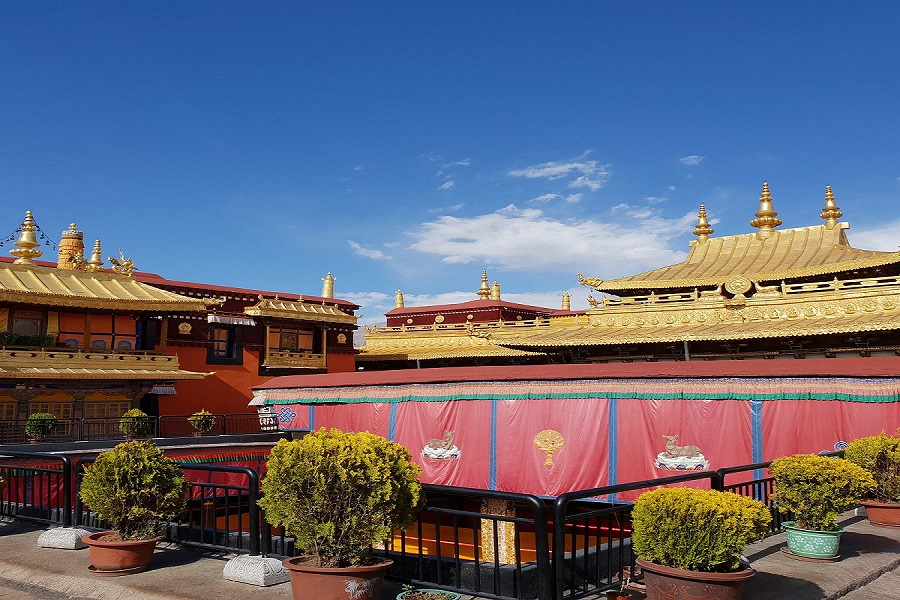
Jokhang Temple
Best Times to Visit
For travelers planning a journey to Lhasa, timing your visit to the Jokhang Temple is essential for a fulfilling experience. Early in the morning, the temple is filled with devout Tibetans who come to offer their prayers and engage in daily rituals. While this early bustle offers a glimpse into the living traditions of the temple, it can be quite crowded. Many seasoned visitors recommend exploring the temple in the afternoon when the atmosphere is slightly more relaxed, yet the spiritual energy remains palpable.
Navigating the Temple Complex
Entering the Jokhang Temple is an experience steeped in reverence. The main gate is flanked by statues of four Guardian Kings, whose solemn expressions remind visitors of the sacred duty of protection entrusted to the temple. As you pass through the gate, you will observe pilgrims in deep meditation and prostration, each act of devotion contributing to the temple’s vibrant spiritual tapestry.
Inside the temple complex, the layout is designed to guide visitors through a series of chapels and halls, each dedicated to a different aspect of Tibetan Buddhist practice. Starting at the main hall, one can witness the impressive statues of Padma Sambhava (Guru Rinpoche) and Maitreya, the Future Buddha, before progressing to the more intimate chapels dedicated to Tsongkhapa, the eight Medicine Buddhas, and Avalokiteshvara. Each shrine provides a unique perspective on Buddhist philosophy and the diverse practices that have flourished in Tibet over the centuries.
Immersing Yourself in the Spiritual Atmosphere
A visit to the Jokhang Temple is as much about introspection as it is about exploration. The rhythmic chants of monks, the sight of devout pilgrims, and the intricate murals depicting the history of Buddhism all work together to create an environment that is both awe-inspiring and deeply meditative. Taking time to walk slowly, absorb the details of ancient artwork, and reflect upon the stories embedded in every stone is an essential part of the experience.
For those with an interest in photography, the temple offers countless opportunities to capture its beauty from multiple angles. From the meticulously restored interior halls to the panoramic views available from the rooftop, every perspective of the Jokhang Temple is imbued with a timeless quality. Remember, however, that respectful behavior is paramount, as the temple remains an active place of worship.
Engaging with Local Culture
In addition to its religious and historical attractions, the Jokhang Temple serves as a gateway to understanding the local culture of Lhasa. The bustling markets, traditional tea houses, and local artisans who line the streets around the temple offer further insights into the rich tapestry of Tibetan life. Engaging with local guides can enrich your visit, providing context and personal anecdotes that bring the temple’s legends and traditions to life.
Start an Adventure Trip to Jokhang Temple
For anyone seeking to understand the true essence of Tibetan Buddhism, a visit to the Jokhang Temple is a pilgrimage in itself—a journey that connects you with a rich tapestry of history, art, and enduring faith. Its legacy continues to be written with every new generation, ensuring that the spiritual heart of Lhasa beats strong for centuries to come.
Contact us directly, as a local travel agency in Tibet, to help you complete the adventure trip to Jokhang Temple.

